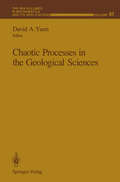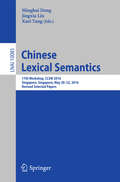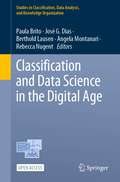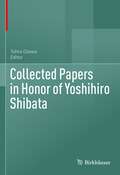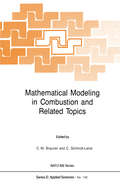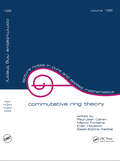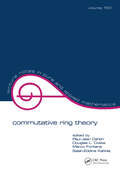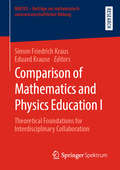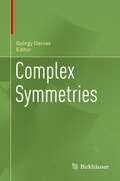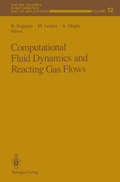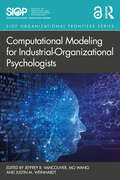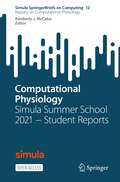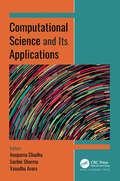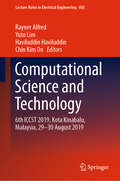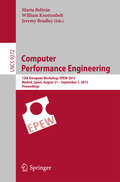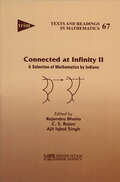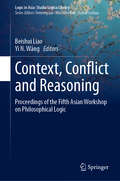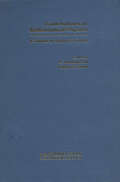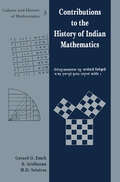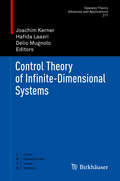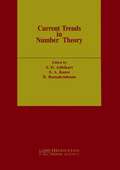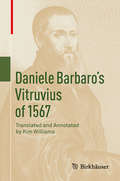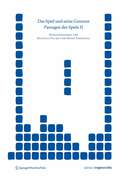- Table View
- List View
Chaotic Processes in the Geological Sciences (The IMA Volumes in Mathematics and its Applications #41)
This IMA Volume in Mathematics and its Applications CHAOTIC PROCESSES IN THE GEOLOGICAL SCIENCES is based on the proceedings of a workshop which was an integral part of the 1989- 90 IMA program on "Dynamical Systems and their Applications". The workshop was intended to be an arena for scientific exchanges between earth scientists and mathematical researchers, especially with experts in dynamical systems. We thank Shui-Nee Chow, Martin Golubitsky, Richard McGehee, George R. Sell and David Yuen for organizing the meeting. We especially thank David Yuen for editing the proceedings. We also take this opportunity to thank those agencies whose financial support made the workshop possible: the Army Research Office, the Minnesota Supercomputer Institute, the National Science Foundation, and the Office of Naval Research. A vner Friedman Willard Miller, Jr. PREFACE The problems in geological sciences have many nonlinearities from the nature of the complicated physical laws which give rise to strongly chaotic behavior. Foremost and most visible are earthquakes and volcanic eruptions, more subtle are the time dependent variations of the Earth's magnetic fields and motions of the surface plates.
Chinese Lexical Semantics: 17th Workshop, CLSW 2016, Singapore, Singapore, May 20–22, 2016, Revised Selected Papers (Lecture Notes in Computer Science #10085)
This book constitutes the thoroughly refereed post-workshop proceedings of the 17th Chinese Lexical Semantics Workshop, CLSW 2016, held in Singapore, Singapore, in May 2016. The 70 regular papers included in this volume were carefully reviewed and selected from 182 submissions. They are organized in topical sections named: lexicon and morphology, the syntax-semantics interface, corpus and resource, natural language processing, case study of lexical semantics, extended study and application.
Classification and Data Science in the Digital Age (Studies in Classification, Data Analysis, and Knowledge Organization)
The contributions gathered in this open access book focus on modern methods for data science and classification and present a series of real-world applications. Numerous research topics are covered, ranging from statistical inference and modeling to clustering and dimension reduction, from functional data analysis to time series analysis, and network analysis. The applications reflect new analyses in a variety of fields, including medicine, marketing, genetics, engineering, and education.The book comprises selected and peer-reviewed papers presented at the 17th Conference of the International Federation of Classification Societies (IFCS 2022), held in Porto, Portugal, July 19–23, 2022. The IFCS federates the classification societies and the IFCS biennial conference brings together researchers and stakeholders in the areas of Data Science, Classification, and Machine Learning. It provides a forum for presenting high-quality theoretical and applied works, and promoting and fostering interdisciplinary research and international cooperation. The intended audience is researchers and practitioners who seek the latest developments and applications in the field of data science and classification.
Collected Papers in Honor of Yoshihiro Shibata
Yoshihiro Shibata has made many significant contributions to the area of mathematical fluid mechanics over the course of his illustrious career, including landmark work on the Navier-Stokes equations. The papers collected here — on the occasion of his 70th birthday — are written by world-renowned researchers and celebrate his decades of outstanding achievements.
Commutative Algebra: Proceedings of a Microprogram Held June 15–July 2, 1987 (Mathematical Sciences Research Institute Publications #15)
During late June and early July of 1987 a three week program (dubbed "microprogram") in Commutative Algebra was held at the Mathematical Sciences Research Institute at Berkeley. The intent of the microprogram was to survey recent major results and current trends in the theory of commutative rings, especially commutative Noetherian rings. There was enthusiastic international participation. The papers in this volume, some of which are expository, some strictly research, and some a combination, reflect the intent of the program. They give a cross-section of what is happening now in this area. Nearly all of the manuscripts were solicited from the speakers at the conference, and in most instances the manuscript is based on the conference lecture. The editors hope that they will be of interest and of use both to experts and neophytes in the field. The editors would like to express their appreciation to the director of MSRI, Professor Irving Kaplansky, who first suggested the possibility of such a conference and made the task of organization painless. We would also like to thank the IVISRI staff who were unfailingly efficient, pleasant, and helpful during the meeting, and the manager of MSRI, Arlene Baxter, for her help with this volume. Finally we would like to express our appreciation to David Mostardi who did much of the typing and put the electronic pieces together.
Commutative Ring Theory: Proceedings of the Ii International Conference
Presents the proceedings of the Second International Conference on Commutative Ring Theory in Fes, Morocco. The text details developments in commutative algebra, highlighting the theory of rings and ideals. It explores commutative algebra's connections with and applications to topological algebra and algebraic geometry.
Commutative Ring Theory
" Exploring commutative algebra's connections with and applications to topological algebra and algebraic geometry, Commutative Ring Theory covers the spectra of rings chain conditions, dimension theory, and Jaffard rings fiber products group rings, semigroup rings, and graded rings class groups linear groups integer-valued polynomials rings of finite fractions big Cohen-Macaulay modules and much more!"
Comparison of Mathematics and Physics Education I: Theoretical Foundations for Interdisciplinary Collaboration (MINTUS – Beiträge zur mathematisch-naturwissenschaftlichen Bildung)
This volume, which is the output of a DAAD-funded collaboration between the University of Siegen and the Hanoi National University of Education, discusses and summarizes theoretical foundations of common grounds of mathematics and physics education. This interdisciplinary perspective enables especially teachers who have only been trained in one of these subjects to enrich their pedagogical content knowledge. The starting point is a description of characteristics of the disciplines and their historical genesis, followed by comparative studies. This edited volume brings together thirteen stimulating contributions on educational aspects of both disciplines written jointly by experienced researchers from Germany and Vietnam.
Complex Symmetries
This volume is a collection of essays on complex symmetries. It is curated, emphasizing the analysis of the symmetries, not the various phenomena that display those symmetries themselves. With this, the volume provides insight to nonspecialist readers into how individual simple symmetries constitute complex symmetry. The authors and the topics cover many different disciplines in various sciences and arts. Simple symmetries, such as reflection, rotation, translation, similitude, and a few other simple manifestations of the phenomenon, are all around, and we are aware of them in our everyday lives. However, there are myriads of complex symmetries (composed of a bulk of simple symmetries) as well. For example, the well-known helix represents the combination of translational and rotational symmetry. Nature produces a great variety of such complex symmetries. So do the arts. The contributions in this volume analyse selected examples (not limited to geometric symmetries). These include physical symmetries, functional (meaning not morphological) symmetries, such as symmetries in the construction of the genetic code, symmetries in human perception (e.g., in geometry education as well as in constructing physical theories), symmetries in fractal structures and structural morphology, including quasicrystal and fullerene structures in stable bindings and their applications in crystallography and architectural design, as well as color symmetries in the arts. The volume is rounded of with beautiful illustrations and presents a fascinating panorama of this interdisciplinary topic.
Computational Fluid Dynamics and Reacting Gas Flows (The IMA Volumes in Mathematics and its Applications #12)
This IMA Volume in Mathematics and its Applications COMPUTATIONAL FLUID DYNAMICS AND REACTING GAS FLOWS is in part the proceedings of a workshop which was an integral part of the 1986-87 IMA program on SCIENTIFIC COMPUTATION. We are grateful to the Scientific Committee: Bjorn Engquist (Chairman), Roland Glowinski, Mitchell Luskin and Andrew Majda for planning and implementing an exciting and stimulating year-long program. We especially thank the Workshop Organizers, Bjorn Engquist, Mitchell Luskin and Andrew Majda, for organizing a workshop which brought together many of the leading researchers in the area of computational fluid dynamics. George R. Sell Hans Weinberger PREFACE Computational fluid dynamics has always been of central importance in scientific computing. It is also a field which clearly displays the essential theme of interaction between mathematics, physics, and computer science. Therefore, it was natural for the first workshop of the 1986- 87 program on scientific computing at the Institute for Mathematics and Its Applications to concentrate on computational fluid dynamics. In the workshop, more traditional fields were mixed with fields of emerging importance such as reacting gas flows and non-Newtonian flows. The workshop was marked by a high level of interaction and discussion among researchers representing varied "schools of thought" and countries.
Computational Modeling for Industrial-Organizational Psychologists (SIOP Organizational Frontiers Series)
This collection provides a primer to the process and promise of computational modeling for industrial-organizational psychologists. With contributions by global experts in the field, the book is designed to expand readers’ appreciation for computational modeling via chapters focused on key modeling achievements in domains relevant to industrial-organizational psychology, including decision making in organizations, diversity and inclusion, learning and training, leadership, and teams.To move the use of computational modeling forward, the book includes specific how-to-chapters on two of the most commonly used modeling approaches: agent-based modeling and system dynamics modeling. It also gives guidance on how to evaluate these models qualitatively and quantitatively, and offers advice on how to read, review, and publish papers with computational models. The authors provide an extensive description of the myriad of values computational modeling can bring to the field, highlighting how they offer a more transparent, precise way to represent theories and can be simulated to offer a test of the internal consistency of a theory and allow for predictions. This is accompanied by an overview of the history of computational modeling as it relates to I-O psychology. Throughout, the authors reflect on computational modeling’s journey, looking back to its history as they imagine its future in I-O psychology.Each contribution demonstrates the value and opportunities computational modeling can provide the individual researcher, research teams, and fields of I-O psychology and management. This volume is an ideal resource for anyone interested in computational modeling, from scholarly consumers to computational model creators.Chapter 1 of this book is freely available as a downloadable Open Access PDF at http://www.taylorfrancis.com under a Creative Commons Attribution-Non Commercial-No Derivatives (CC-BY-NC-ND) 4.0 license.
Computational Physiology: Simula Summer School 2021 − Student Reports (Simula SpringerBriefs on Computing #12)
This open access volume compiles student reports from the 2021 Simula Summer School in Computational Physiology. Interested readers will find herein a number of modern approaches to modeling excitable tissue. This should provide a framework for tools available to model subcellular and tissue-level physiology across scales and scientific questions. In June through August of 2021, Simula held the seventh annual Summer School in Computational Physiology in collaboration with the University of Oslo (UiO) and the University of California, San Diego (UCSD). The course focuses on modeling excitable tissues, with a special interest in cardiac physiology and neuroscience. The majority of the school consists of group research projects conducted by Masters and PhD students from around the world, and advised by scientists at Simula, UiO and UCSD. Each group then produced a report that addreses a specific problem of importance in physiology and presents a succinct summary of the findings. Reports may not necessarily represent new scientific results; rather, they can reproduce or supplement earlier computational studies or experimental findings. Reports from eight of the summer projects are included as separate chapters. The fields represented include cardiac geometry definition (Chapter 1), electrophysiology and pharmacology (Chapters 2–5), fluid mechanics in blood vessels (Chapter 6), cardiac calcium handling and mechanics (Chapter 7), and machine learning in cardiac electrophysiology (Chapter 8).
Computational Science and Its Applications
This new volume explores the overlapping behavior of some aspects of computational science, focusing on the intersection of computing hardware, algorithms, mathematics, and data management components. The chapters discuss the various application areas of the computational science techniques such as artificial intelligence, machine learning, data science, quantum computing, image processing, evolutionary algorithms, process simulation, deep learning, big data analysis, etc.
Computational Science and Technology: 6th ICCST 2019, Kota Kinabalu, Malaysia, 29-30 August 2019 (Lecture Notes in Electrical Engineering #603)
This book gathers the proceedings of the Sixth International Conference on Computational Science and Technology 2019 (ICCST2019), held in Kota Kinabalu, Malaysia, on 29–30 August 2019. The respective contributions offer practitioners and researchers a range of new computational techniques and solutions, identify emerging issues, and outline future research directions, while also showing them how to apply the latest large-scale, high-performance computational methods.
Computer Performance Engineering: 12th European Workshop, EPEW 2015, Madrid, Spain, August 31 - September 1, 2015, Proceedings (Lecture Notes in Computer Science #9272)
This book constitutes the refereed proceedings of the 12th European Workshop on Computer Performance Engineering, EPEW 2015, held in Madrid, Spain, in August/September 2015. The 19 papers presented in this volume were carefully reviewed and selected from 39 submissions. They were organized in topical sections named: applications; modelling techniques, software performance, and simulation techniques.
Congruency
This diagram consists of two pairs of congruent shapes; two triangles in the middle of the page and two irregular shapes at the bottom of the page. A locator dot and title are shown. These must always be at the top left of the page when the image is the right way up. The top two are congruent - the one on the right is in a mirrored position. The diagram shows how their congruency is proved. The bottom two are also congruent - the one on the right is in a rotated position. When shapes are congruent they are the same size and shape but can be rotated and/or mirrored.
Congruency
This diagram consists of two pairs of congruent shapes; two triangles in the middle of the page and two irregular shapes at the bottom of the page. A locator dot and title are shown. These must always be at the top left of the page when the image is the right way up. The top two are congruent - the one on the right is in a mirrored position. The diagram shows how their congruency is proved. The bottom two are also congruent - the one on the right is in a rotated position. When shapes are congruent they are the same size and shape but can be rotated and/or mirrored.
Connected at infinity II: a selection of mathematics by Indians (Texts and Readings in Mathematics #67)
Context, Conflict and Reasoning: Proceedings of the Fifth Asian Workshop on Philosophical Logic (Logic in Asia: Studia Logica Library)
This volume brings together a group of philosophically oriented logicians and logic-minded philosophers, mainly from Asia, to address a variety of logical and philosophical topics, such as modal logic and related directions (e.g. temporal logic, epistemic logic, deontic logic, logic of conditionals, and modal proof theory), theory of truth, paradoxes, intentionality, and social networks. New approaches are also proposed, such as extended modal logic with planarity of graphs, extended branching time temporal logic with conditional operators, and a relational treatment of language and logical systems, to name but a few.Given the variety of topics and issues discussed here, the book will appeal to readers from a broad range of disciplines, from mathematical/philosophical logic, computing science, cognitive science and artificial intelligence, to linguistics, game theory and beyond.
Contributions in Mathematical Physics: A Tribute to Gerard G. Emch
Professor Gerard G. Emch has been one of the pioneers of the C-algebraic approach to quantum and classical statistical mechanics. In a prolific scientific career, spanning nearly five decades, Professor Emch has been one of the creative influences in the general area of mathematical physics. The present volume is a collection of tributes, from former students, colleagues and friends of Professor Emch, on the occasion of his 70th birthday. The articles featured here are a small yet representative sample of the breadth and reach of some of the ideas from mathematical physics.It is also a testimony to the impact that Professor Emch's work has had on several generations of mathematical physicists as well as to the diversity of mathematical methods used to understand them.
Contributions to the History of Indian Mathematics (Culture And History Of Mathematics #3)
This volume consists of a collection of articles based on lectures given by scholars from India, Europe and USA at the sessions on 'History of Indian Mathematics' at the AMS-India mathematics conference in Bangalore during December 2003. These articles cover a wide spectrum of themes in Indian mathematics. They begin with the mathematics of the ancient period dealing with Vedic Prosody and Buddhist Logic, move on to the work of Brahmagupta, of Bhaskara, and that of the mathematicians of the Kerala school of the classical and medieval period, and end with the work of Ramanaujan, and Indian contributions to Quantum Statistics during the modern era. The volume should be of value to those interested in the history of mathematics.
Control Theory of Infinite-Dimensional Systems (Operator Theory: Advances and Applications #277)
This book presents novel results by participants of the conference “Control theory of infinite-dimensional systems” that took place in January 2018 at the FernUniversität in Hagen. Topics include well-posedness, controllability, optimal control problems as well as stability of linear and nonlinear systems, and are covered by world-leading experts in these areas. A distinguishing feature of the contributions in this volume is the particular combination of researchers from different fields in mathematics working in an interdisciplinary fashion on joint projects in mathematical system theory. More explicitly, the fields of partial differential equations, semigroup theory, mathematical physics, graph and network theory as well as numerical analysis are all well-represented.
Daniele Barbaro’s Vitruvius of 1567
This is the first-ever English translation of Daniele Barbaro’s 1567 Italian translation of and commentary on Vitruvius’s Ten Books of Architecture, an encyclopaedic treatment of science and technology whose influence extended far beyond its day. Intended to both interpret and expand upon the Vitruvian text, Barbaro’s erudite commentary reflects his Aristotelian approach, particularly his fascination with the relationship between science and the arts. This treatise offers a window onto the architectural ideals of the 1500s, as well as then-current notions of philosophy, mathematics, music, astronomy, mechanics, and more. The text is accompanied by illustrations by the Renaissance architect Andrea Palladio and his contemporaries. Palladio’s own Four Books on Architecture, published in 1570, was just one of many treatises on architecture that was inspired by the ideas contained here.An overview of Daniele Barbaro’s thinking is presented in a foreword by Branko Mitrovic´. The collocation of Barbaro’s treatise between those of Alberti and Palladio is addressed in a foreword by Robert Tavernor. Kim Williams provides a translator’s note to orient the reader. The text of the translation is cross-referenced to both Barbaro's 1567 publication and standard divisions of Vitruvius. The volume includes a detailed index of subjects and an index of proper names.
Das Spiel und seine Grenzen: Passagen des Spiels II (Edition Angewandte)
Spiel ist heute ins Zentrum der Kulturwissenschaften gerückt. In seinen Regeln, seinem Design und den Erzählungen, die es generiert, ist Spiel die Arena gesellschaftspolitischer und ästhetischer Konflikte und der ökonomisch bedeutendste Sektor der Freizeit- und Bewusstseinsindustrie der Gegenwart.Die Konjunktur des Spielbegriffs kennzeichnet den Übergang einer Erwerbs- und Leistungsgesellschaft zu einer Chancen- und Risikogesellschaft. Doch: Wer spielt? Wer gewinnt und wer verliert? Wer bestimmt die Regeln des Spiels?„Das Spiel und seine Grenzen" untersucht kritisch die Struktur und Grenzen des Spiels in der Kunst, Philosophie, Kulturindustrie und Ökonomie im 20. und zu Beginn des 21. Jahrhunderts.Die Beiträge sind den spieltheoretischen Werken und Anmerkungen unter anderem bei Johan Huizinga, Theodor W. Adorno und Sigmund Freud gewidmet. Betrachtet werden aber auch die Spiel-Räume in Städten und in den Multiplayer Online Welten des Internet, das Verhältnis von Spiel und Kunst bei Marcel Duchamp, in der Performance Art und im Kriminalroman sowie – last not least – das Spiel mit dem Geld im Hazardkapitalismus der unmittelbaren Gegenwart.
